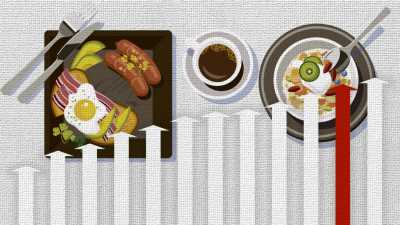
Save articles for later
Add articles to your saved list and come back to them any time.
Whether you’re a sweet tooth or a savoury person, the cost of making brunch has risen considerably over the past year as the prices of everyday items have grown with inflation. But some ingredients will set you back much more than others.
Inflation fell to 6 per cent in the year to June, the second consecutive quarter of lower annual inflation.
The cost of making brunch has risen considerably over the past year as the prices of everyday items have grown with inflation.Credit: Jamie Brown
For food, annual inflation has eased by half a percentage point but it remains high, at 7.5 per cent in June. That’s down from 8 per cent in March, and 9.2 per cent in December.
Price rises over the last 12 months were highest for dairy products (up 15.2 per cent) and bread and cereals (up 11.6 per cent), while increases for fresh food were smaller, with meat and seafood up by 3.5 per cent over the year, and fruit and vegetable prices rising by just 1.6 per cent.
How are these price changes measured?
Inflation does not work evenly across all the things households buy. The prices of some goods and services will rise faster than others or even continue to rise as others fall, depending on factors from consumer demand and business supply, to natural disasters and holiday periods.
In its consumer price index, the ABS looks at price changes across a range of ordinary goods and services purchased regularly by households.
This “basket” of goods is weighted, depending on how many of those goods households typically buy. Australians spend less and less on tobacco products, for example, but nearly a quarter of the inflation basket is taken up by housing.
The quarterly inflation figures from the ABS are more robust than the monthly figures – firstly the quarterly figures measure more price changes, and because there is more data it is less volatile.
To take a closer look at how inflation changes, and can differ from product to product, we’re diving into the inflation data every three months to see how the prices for the ingredients for some breakfast favourites have changed.
This isn’t an index in the classic sense – we would need to weigh all the brunch ingredients and create one graph for that – but not everyone eats and drinks all these items, and it’s interesting to see how much prices change in specific products (coffee, we’re looking at you).
Cut through the noise of federal politics with news, views and expert analysis from Jacqueline Maley. Subscribers can sign up to our weekly Inside Politics newsletter here.
Most Viewed in Politics
From our partners
Source: Read Full Article
